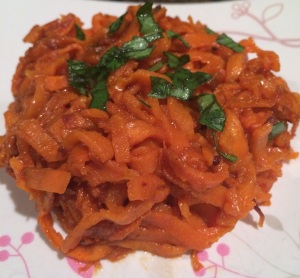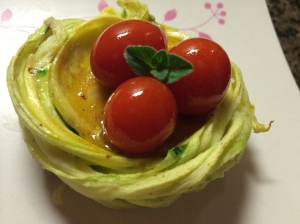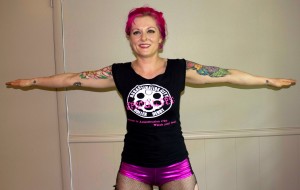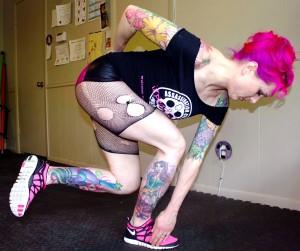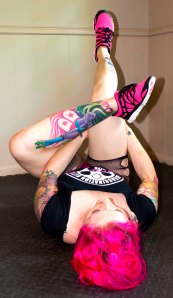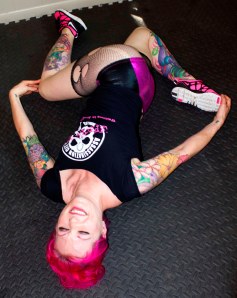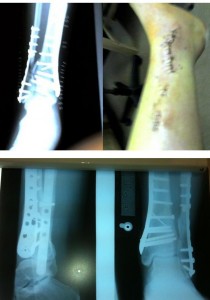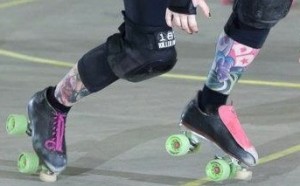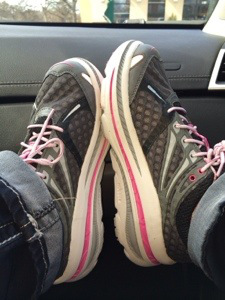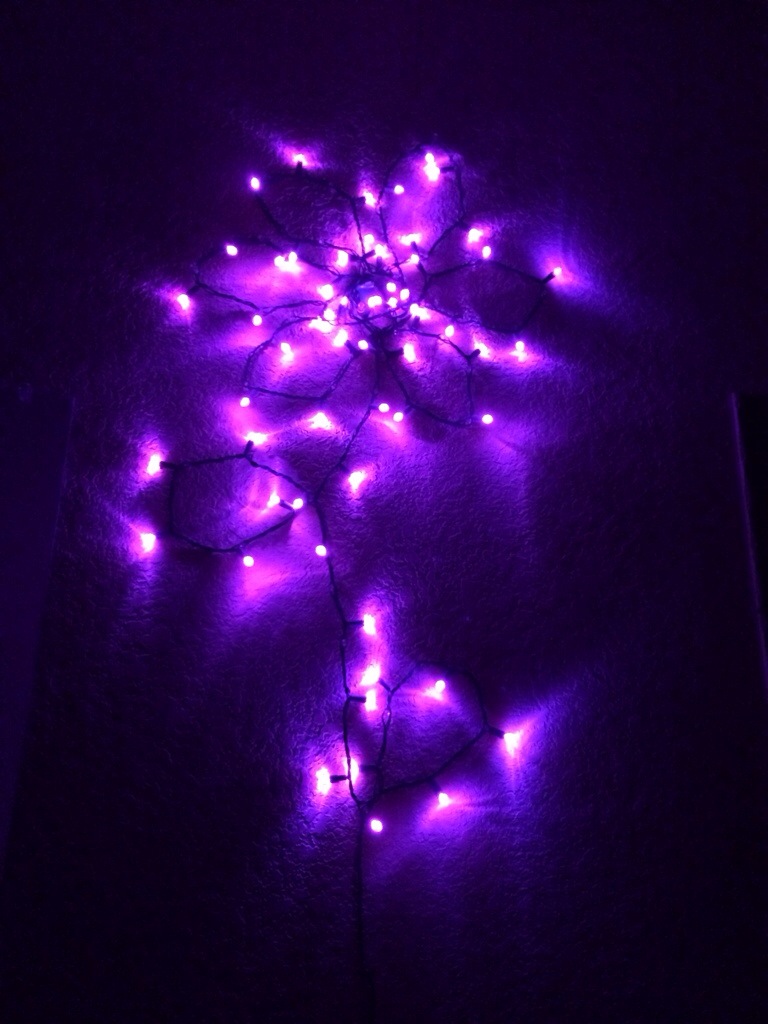I originally wrote this on my league forum as a post for the fresh meat group I was coaching at the time. I shared it on Facebook later for a rec league group I was training, and by request I’m sharing it here now in its original entirety. I hope it continues to inspire and motivate aspiring derby athletes.
…………………………………..
I’ve been meaning to put this out here for awhile – I posted it on my league board recently in a nutrition and fitness thread for my freshies. There aren’t a lot of old guard left who remember what my life was like when I first joined Assassination City & I don’t want anyone to ever assume that I’ve always been who and what I am, because it’s taken a lot of hard work to get here.
This will be really, really long, so bear with me. I talk a lot. Plus, I’m a narcissist who needs visual aids to fully illustrate the changes my body has gone through, so you get pics too.
I was small (unhealthily so, but that’s a confession for another time) until I hit my early 20s, then birth control (& later fertility meds – oh, the irony) + eating way too much crappy food + sitting at a desk all day reshaped me. I weighed about 155 when I finally became pregnant with Victoria – then I put on 63 pregnancy pounds. Yeah, that’s not a typo. I’m 5’4″ & I weighed 218lbs when I checked into the hospital. That’s over twice the size I was when I met V’s dad. Some of it was the swelling from pre-eclampsia, but most of it was the fact that I used pregnancy as an excuse to eat everything in sight (mostly processed garbage & greasy fast food) & I told myself that walking the dog was actually real exercise.
Here’s what I looked like pregnant (with my best friend Jackie O’NiceAss @ her baby shower):

Our kids were born two days apart.
And right after I had V (rare pic of natural haircolor):

V had severe GERD, which took a trip to the emergency rom and several specialists and procedures to diagnose. Sickly, unhappy new baby + scary new body and wild hormones did a number on my self-esteem, so I spent the first 4 months of V’s life in misery on so many levels. I didn’t realize at the time I had PPD, but I can see now how bad it really was. I felt very alone and I needed an outlet.
When V was about 4 months old, Jackie O & I started talking about roller derby again. We’d heard about it for the first time @ the baby shower where the above pic of us was taken & we had made a pact that we would join after we had our babies. After researching local leagues, I attended a DDD bout one weekend and an ACRD bout the next. Dude, I was hooked within the first 2 jams. It was pure awesome. I contacted ACRD about 2 hours after their bout & joined within the next month (summer of ’06).
My skating background: rink rat as a kid + speed team when I realized that skating was faster than running (I’ve loved running since I learned how to do it). I hadn’t been on skates in 17 years, though. I went to a public session the day before my first practice and rented a pair of brownies. I was on the floor for 15 mins when a 12 year old asked me to teach her how to cross on the corners, so I guess it came back to me pretty fast. Muscle memory amazes me.
First practice: I lasted 45 minutes. I was so out of shape! I’d been walking every day & had progressed to light jogging again since I had V, so I was probably down to 185 when I strapped on my skates. My bad knee hated me because of all of the weight I was forcing down on it. The coach was less than kind about my inability to keep up, the veterans blatantly ignored me and I felt so far out of my element physically and socially. Fortunately, Gloria Vanderbitch sat down next to me during a water break and within two sentences became one of my best friends for life – so I swallowed my pride and fears, stuck around and came back the next week. I made it through the entirety of the next practice & every practice after that, & soon my body and mind began to transform.
In my first year of derby, I lost about 25 pounds…I didn’t do much else besides skate. I was eating less, but still eating like crap – my first home team, La Revolucion, used to get bourbon & pancakes @ this dive bar called Bandera after every practice. Not exactly the best post-exercise nutrition. Still, I was a pretty decent jammer & I used my size to my advantage – but more importantly, a year of hanging out with a group of strong, beautiful, confident women who come in all shapes & sizes reshaped my self-image & helped me love myself again.

La Rev Py
I shattered my leg (11 breaks in the tibia/fibula) on June 6 of ’07 – had surgery June 11 (2 plates, 17 screws and one stabilizing rod), attended the pre-bout party in a wheelchair on June 15, & went to the bout + separated from the Giant on June 17. It was a busy, fuzzy week of pain and confusion. The Divorce Diet will make you drop weight fast, but I don’t recommend it – nor do I recommend crawling into a bottle of whiskey for a year, which is what I did. Weight fell off to the point that people were asking if I was doing coke. (I was not. I was just drinking myself to death.) I think I was probably 112 @ my skinniest – West Texas flung me around the rink in July of ’08 (my first bout back as a skater) like a rag doll.

EAT SOMETHING.
** Around this time, I started practicing yoga + meditating every day. I needed to regain my balance in every sense of the word. Yoga changed a lot about my life for the better – I cannot say enough good things about practicing on a regular basis. I healed physically, mentally & spiritually through yoga. It made me more mindful of every bite I put in my mouth, every drink I took, every minute wasted in a bar or stuffing my face in front of the TV that could have been filled with something meaningful & productive. I also started keeping a journal, which made it easier to track whether I was stress-eating or forgetting to eat bc I’d drank too much. A journal shines so much light on what’s going on inside you, & that helps shape the outside. **
I sprained my right ankle in Dec ’08 but kept skating on it in pain ’til about Feb ’09. I do NOT recommend that – if you have an inversion sprain, get off your skates & heal. I opted for 3x per wk physical therapy bc I wanted to recover as quickly as possible. Physical therapy strengthened both ankles, plus it helped build some muscle in my legs (stability exercises are SO good for your entire lower body & core). It made me feel stronger, & I love feeling strong! I started running again (a slow and painful process with nuts’n’bolts in my leg, but it is possible to run again if you have been broken and rebuilt) & I bought a couple of circuit-training DVDs featuring HIIT (high intensity interval training, which is the quickest way to get in bad-ass shape). I highly recommend Jackie Warner’s DVDs – she will destroy you in a very short amount of time. The key is to understand that exercise is supposed to be uncomfortable to some degree – you have to sweat to burn fat & build muscle.
After a year of lifting @ home, Smack the Ripper talked me into joining her gym in May ’10 – I hired a personal trainer & fell in love with her job, so I started the NASM PFT program in July ’10 & started hitting the weights & Stairmaster hard. I received my NASM PFT certification in April of ’11 and have since added several specialized certifications to my arsenal of training knowledge.
So, to make a short story very, very long, that’s why your off skates warmups are so intense – and that’s why I now look like this:

I’m impressed if you made it through that long ramble. I feel a bit as if I’ve exposed my soft underbelly to you all, figuratively & literally. I work my ass off on the daily because I know I’m never going to be a final product – I’m always a work in progress. We all are. I take my nutrition one day @ a time, focusing on eating clean 95% of the time & I don’t beat myself up if I eat a yummy fatty treat every now & then (although once I started eating clean, I stopped craving sugar and fat as much – I’m repulsed by fast food and most processed crap now). I break a sweat @ least once a day – cardio is good for the body, heart, mind, soul. Cardio is good working meditation for people who can’t hold still for long (like me). Lifting weights makes me feel powerful – that power carries over into life outside the gym and off the track. Lean muscle burns fat even when we’re asleep, so my body is a self-maintaining machine. I quit drinking on Nov 1, 2009 and I don’t miss it @ all. I realize I am an extreme case and your mileage may vary – I don’t expect anyone to quit drinking or enjoying an occasional piece of cake – I’m an all-or-nothing kind of gal, so it works for me.
Bottom line out of all of this, the one point to take home with you – derby can change your life in many positive & amazing ways, but it’s only the beginning of being truly fit & healthy. Think of derby as the gateway drug to lifetime fitness and health. Derby practice alone will not turn us into powerful lean machines – we have to put hard work in to get great results out of what we do every day. That daily hard work will show up on the track and in every other aspect of our lives.
Thank you for listening.


